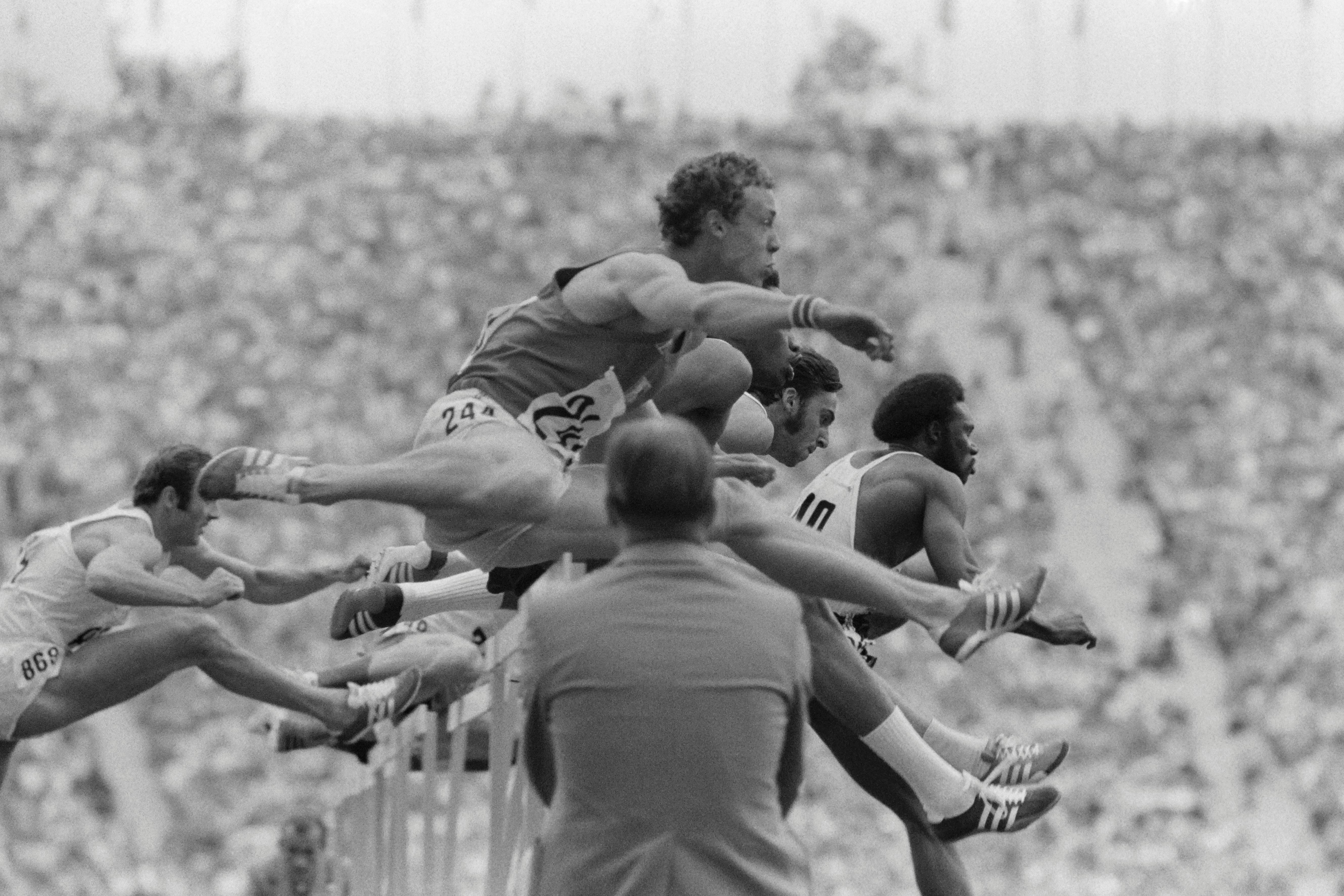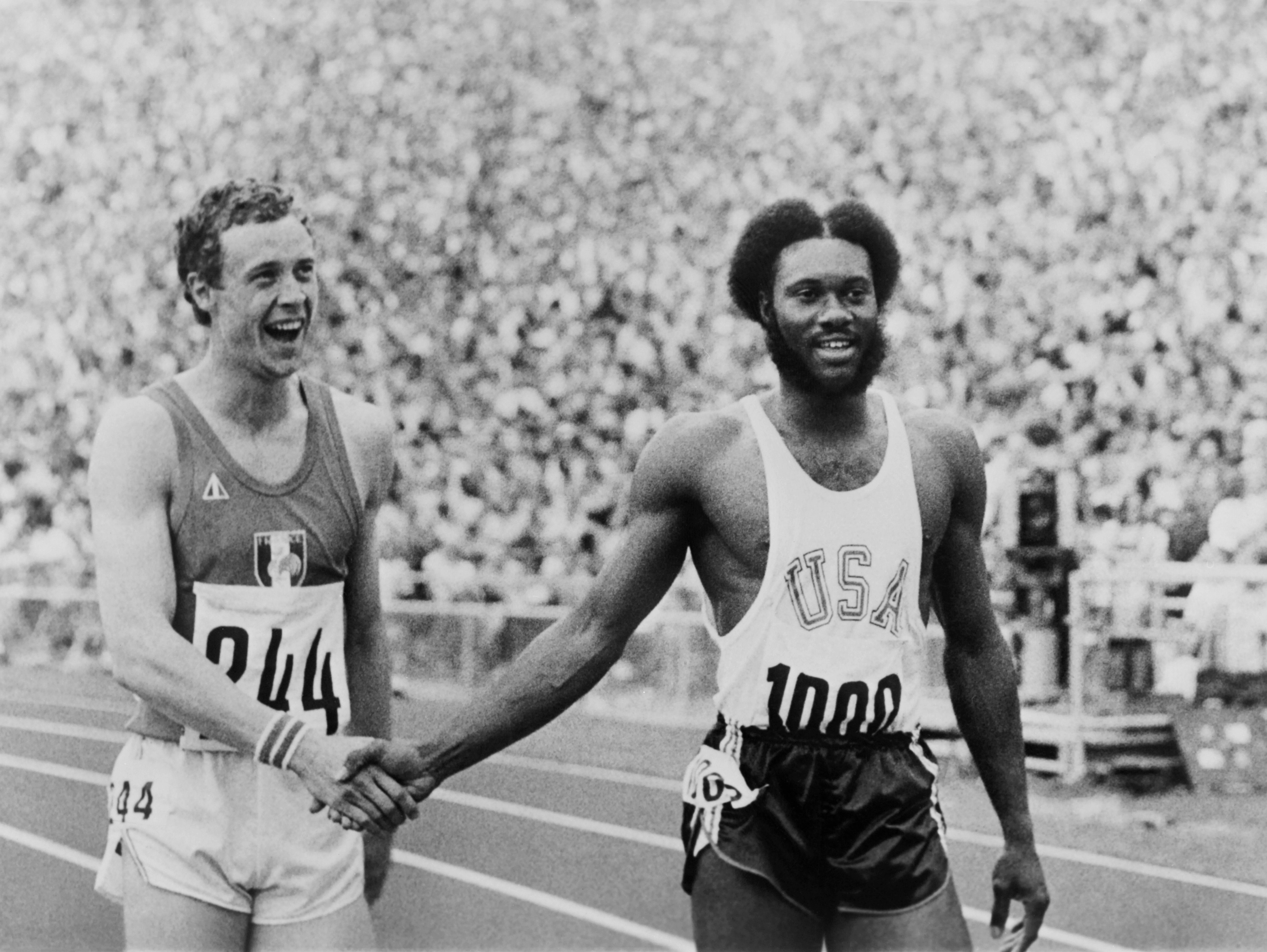US 110m hurdler Rod Milburn (© Allsport / Getty Images)
It was not the first time that a lightning-fast master of the high hurdles had struck in world record fashion in the track and field crucible of Zurich’s Letzigrund Stadium. Nor was it to be the last.
But when Rodney Milburn Jr – “Hot Rod” to the sporting press, “Dice” to his friends and acquaintances in Opelousas, Louisiana – flashed across the finish line in the 1973 Weltklasse meeting 50 years ago, it was a landmark occasion in the history of the 110m hurdles.
At the Munich Olympics the previous year, the quietly spoken, self-effacing Milburn had equalled the world record, powering to the gold medal in 13.24, 0.10 ahead of the fast-finishing Frenchman Guy Drut.
In the process, he became the third man to match the hand-timed global mark of 13.2, following in the spike-marks of three fellow US hurdlers. Lee Calhoun, the 1956 and 1960 Olympic champion, achieved the feat in Bern in 1960. Earl McCullouch replicated it in Minneapolis in 1967. And Willie Davenport, the 1968 Olympic champion and collegiate teammate, mentor and rival of Milburn, clocked 13.2 in Zurich in 1969.

Rod Milburn leads the 110m hurdles at the 1972 Olympics in Munich (© AFP / Getty Images)
Lauer – a lecture, a plane, a boat, and the Letzigrund
The original 13.2 world record had become the oldest surviving major global mark in the book. It was the first of the 25 world records that have either fallen or been equalled at Zurich’s hallowed Weltklasse, the annual so-called “Olympics in one day” of track and field.
The meet itself dates back to 1928 and an appearance by Paavo Nurmi, the Finnish phenomenon who won nine Olympic gold medals. The first world record at the Letzigrund came in 1959, courtesy of one of the many colourful characters who have graced our sport.
On the morning of the 1959 Weltklasse meeting, 7 July, Martin Lauer had been obliged to attend a talk on the mechanics of fluid in the lecture hall at the University of Munich. He then flew to Zurich by plane, hired a boat to get across Lake Zurich and arrived at the Letzigrund just in time to warm up for the 110m hurdles.
He flew out of the blocks and down the track in 13.2, according to all three timekeepers’ watches. The automatic timing registered 13.56, but that was trumped by the hand-timing.
Willie May of the USA, a distant second in 13.6, was so stunned by Lauer’s performance he asked the meeting director to add a 200m hurdles race to the programme so that he could set the record straight. Two hours later, Lauer won that in 22.5. The 10,842 crowd had a second Letzigrund world record to acclaim. May again finished a distant second, in 22.8.
Lauer was just 22 at the time. As a teenager, he had placed fourth in the 110m hurdles and fifth in the decathlon at the 1956 Olympics in Melbourne. At the Olympics in Rome in 1960 he finished fourth in the high hurdles, behind the US trio of Calhoun, May and Hayes Jones, but anchored West Germany to 4x100m gold in a world record-equalling 39.5.
His career came to an abrupt halt when he contracted sepsis from a non-sterile injection. He narrowly avoided having his left leg amputated.
His girlfriend and brother were involved in a car crash on the way to visit him in hospital. His girlfriend died at the scene. His brother died later from his injuries.
Lauer recovered and became a country singer of some renown. His single, Taxi nach Texas (Taxi to Texas), won Radio Luxembourg’s Silver Lion Award for 1964. Another single, Die letzte Rose der Prairie (The last rose of the prairie), sold 500,000 copies.
“I could have run 12.8”
Milburn himself was to encounter cruel tragedy at the end of his sadly curtailed life but his appearance at the 1973 Weltklasse was a triumph to set alongside his Olympic victory across the border in Munich 12 months previously.
Running into a 1.1 headwind, he crossed the line in 13.1 – half a second ahead of Drut. The electronic timing showed 13.41 but with all three watches clocking 13.1, Milburn had finally ended the quest to eclipse Lauer’s historic figures.

Silver medallist Guy Drut and winner Rod Milburn shake hands after the 110m hurdles at the Munich 1972 Olympic Games (© AFP / Getty Images)
Not that he was greatly satisfied. “Under the best conditions, I could have run 12.8,” he maintained, “but I hit a hurdle and had to correct my stride. I guess that cost me two-tenths (0.2). Then the track was wet and that may have cost me another tenth (0.1).”
The greater technician
Milburn was an assiduous student of the high hurdles. Under the guidance of Claude Paxton, who unearthed his talent at JS Clark High School in Opelousas, he developed the double-armed lead technique - to reduce time in the air.
He also practised knocking off dimes placed on top of each hurdle without touching the actual flight. This, of course, was an adaptation of the method adopted by Lord Burghley, David Cecil, who used matchboxes instead of coins (not glasses of champagne, as erroneously depicted in the Oscar-winning film Chariots of Fire).
The British aristocrat was knocked out in the 110m hurdles heats at the Paris Olympics in 1924 but won gold in the 400m hurdles in Antwerp four years later. He went on to become president of the International Amateur Athletics Federation and vice president of the IOC.
Allied to his natural power and speed, Milburn was able to skim the barriers in fluent fashion. He became recognised as the first hurdler to truly sprint over the hurdles on a consistent basis.
As coach Paxton maintained: “Rodney’s nemesis in college, Willie Davenport, was a technician. Rodney was a greater technician.”
That smooth technique brought Milburn to the global forefront in 1971. He went unbeaten in 28 races that season. Two of them were sensational, hinting at what was to come in the following two years.
At the National Intercollegiate Championships in Billings, Montana, on 4 June, he achieved the first 13-flat clocking for the 110m hurdles, albeit with marginal (2.2m/s) illegal wind assistance. Three weeks later, at the AAU Championships in Eugene, Milburn clocked a legal 13.0 for the 120 yards hurdles (109.73m).

Rod Milburn (409) competes at the AAU Championships in Eugene (© Allsport / Getty Images)
His path to Olympic gold in 1972 was not entirely smooth. At the US Trials he almost suffered the same fate as Harrison Dillard in 1948, when the world record-holder lost his stride and failed to finish. Milburn hit two hurdles and barely qualified in third place.
It was a different story in Munich, where he equalled Lauer’s world record and took gold ahead of Drut. But, after breaking the record outright in Zurich in 1973, his fortunes faded.
Tragic death
The Olympic champion and world record-holder tried to make a living in the short-lived International Track Association circuit and then made an unsuccessful foray into American football. He was reinstated as an amateur athlete in 1980 and made a brilliant comeback to rank sixth for the year with 13.40.
In 1983 he became head track coach at his alma mater, Southern University in Baton Rouge, Louisiana, but his contract was not renewed in 1987. He spent the last nine years of his life scraping together a living as a utility crewman at the Georgia Pacific paper manufacturing plant in Port Hudson, Louisiana.
On 11 November 1997, Milburn was uploading a hopper car filled with hot water and sodium chlorate when – apparently overcome by fumes – he fell into the scalding liquid bleach solution. He was found dead, his body covered with chemical burns. He was 47 years old.
The world record Milburn had set in Zurich lasted for two years. Milburn himself equalled it in Siena just 16 days later and Drut did so in Saint Maur in July 1975. The Frenchman broke it in Berlin in August 1975, his 13.0 clocking being logged as the last official hand timed IAAF world record.
As for Zurich and the Letzigrund, the metaphorical high hurdles barriers kept tumbling. At the 1981 Weltklasse, Renaldo ‘Skeets’ Nehemiah became the first man under 13, clocking a scorching 12.93.
At the 1989 meeting, the next stellar US 110m hurdles exponent, Roger Kingdom, improved the mark to 12.92. Some 34 years later, that remains the Weltklasse meeting record.
Simon Turnbull for World Athletics Heritage




